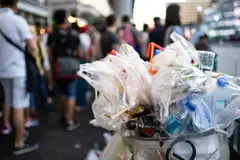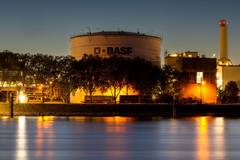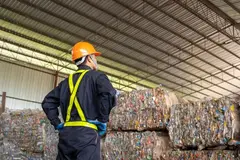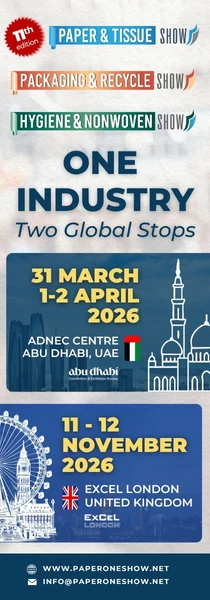European Commission plans to raise plastics levy, industry groups warn of deindustrialization
Key takeaways
- The EC proposes raising the EU Plastics Levy from €0.80 (US$0.94) to €1 (US$1.17) per kg of non-recycled plastic packaging waste.
- Environmental groups support the increase to drive circularity, while plastics industry bodies warn of competitiveness risks and factory closures.
- Critics argue the levy’s impact is limited since most states cover it from general budgets, with calls to broaden its scope and link it more directly to producers.
The EU introduced the Plastics Own Resource levy, known as the EU Plastics Levy, in 2021 to help finance circularity endeavors by charging member states per kilogram of generated non-recycled plastic packaging waste. The European Commission (EC) has now proposed raising the tax by 25% from €0.80 (US$0.94) per kg of waste to €1 (US$1.17).
“A strengthened EU Plastics Levy could have the positive effect of providing stronger incentives for EU member states to act more decisively to reduce non-recycled plastic packaging waste,” Marco Musso, deputy policy manager for Circular Economy and Fiscal Reform at the European Environmental Bureau (EEB), tells Packaging Insights.
“This can be achieved through a more ambitious implementation of the new EU Packaging and Packaging Waste Regulation (PPWR), as well as to encourage them to finally introduce national taxes to recuperate these resources.”
Meanwhile, industry representative groups European Plastics Converters, PETCore Europe, and Plastics Europe have released a joint statement calling on the EC and member states to keep the current pricing.
“The European plastics industry, like other manufacturing industries, is facing severe structural competitiveness issues due to high energy prices, labor, and environmental compliance costs in comparison to manufacturers operating in third countries, leading to a very severe phase of deindustrialization across the entire union.”
“The financial difficulties are resulting in an increasing number of closures of plastics resin manufacturing, recycling, and converting plants. On top of existing challenges, the uncertain trade framework makes it imperative for the EU to safeguard the competitiveness of critical industrial sectors such as plastics and to avoid introducing further burdens that compromise their economic viability and circular transition.”
Financed from national budgets
The EU plastics industry and environmental organizations agree that the Plastics Levy has not been successful in encouraging member states to adopt more circular policies, as intended.
 Marco Musso, deputy policy manager for Circular Economy and Fiscal Reform at the EEB (Image credit: EEB).According to the plastic industry statement, the new EC proposal foresees indirect taxation for companies with a turnover exceeding €100 million (US$118 million), through the Corporate Resources for Europe initiative, as well as the creation or extension of environmental-based indirect taxes.
Marco Musso, deputy policy manager for Circular Economy and Fiscal Reform at the EEB (Image credit: EEB).According to the plastic industry statement, the new EC proposal foresees indirect taxation for companies with a turnover exceeding €100 million (US$118 million), through the Corporate Resources for Europe initiative, as well as the creation or extension of environmental-based indirect taxes.
However, Musso argues: “The levy’s direct impact on circularity has been limited, mainly because the majority of member states opted to cover their contribution from their general state budgets rather than by introducing targeted plastic taxes.”
He says this has weakened the “polluter pays” principle and reduced the incentives for businesses to change behavior. “With this approach, the EU plastics levy is financed by all tax-paying citizens rather than being targeted at the polluters.”
“However, some countries, like Spain, have introduced national plastic packaging taxes in response to the EU plastics levy. Where costs are passed on to producers (for example, via EPR fees or with a national plastic tax), the EU plastics levy can encourage better design for recyclability and investment in reusable alternatives, and/or shifts away from single-use plastic packaging.”
The industry statement notes: “The EU Plastics Levy and national taxes no longer have a positive steering effect, especially since the revenues feed into the general (EU or member state) budget and are not used to foster the circular economy.”
Musso says another limitation of the current EU Plastics Levy is that it only targets plastic packaging, leaving untouched other fast-growing waste streams, like single-use paper or composite packaging. “This can encourage regrettable material substitutions (for example, from single-use plastics to other single-use applications), rather than genuine circular advances such as a shift toward reuse systems.”
Joan Marc Simon, founder at Zero Waste Europe, tells Packaging Insights: “The effectiveness of the levy on promoting circularity or recycling is unknown and unreported. It is unlikely to have had much impact because the levy is designed to be a revenue stream and not an incentive for circularity.”
Incentivizing a circular plastics economy
Simon tells us that the way the EU Plastics Levy is designed today, “and provided the tax is passed on,” will impact producers “for sure,” and potentially recyclers and converters, depending on how the member state decides to pass on the cost.
“As far as the levy is concerned, a good way to promote circularity would be to change the target from unrecycled plastic to virgin plastic production. Like this, the EU would get the revenue it wants and it would support plastic recycling,” he adds.
 Joan Marc Simon, founder at Zero Waste Europe (Image credit: Zero Waste Europe).“For it to have a real impact on circularity, the levy would need to be passed on to producers, target virgin plastic production, and probably be a bit higher than €1 (US$1.17).”
Joan Marc Simon, founder at Zero Waste Europe (Image credit: Zero Waste Europe).“For it to have a real impact on circularity, the levy would need to be passed on to producers, target virgin plastic production, and probably be a bit higher than €1 (US$1.17).”
Musso says the current EU Plastics Levy could be further strengthened as part of the next Multiannual Financial Framework by:
• Broadening the scope to target plastic prevention along the entire value chain (not limited to packaging)
• Including other single-use packaging materials, beyond plastics (for example, non-recycled single-use paper and composite packaging)
• Increasing the levy to provide a stronger economic signal to producers and consumers.
“To my reading, the report of the European Court of Auditors (Special report 16/2024: EU revenue based on non-recycled plastic packaging waste) does not contain arguments against increasing the call rate of the EU Plastics Levy, but it contains interesting reflections on how to improve the reliability and comparability of the data reported by member states on packaging recycling.”
Coordinating with PPWR
Musso says the PPWR aims to make all packaging in the EU recyclable and to ensure that recycling happens in practice, for example, by mandating plastic recycled content. “If implemented ambitiously, the PPWR is thus likely to significantly reduce non-recycled plastic packaging waste.”
“There is no conflict between the PPWR implementation and the proposed increase of the EU plastics levy. On the contrary, the levy will provide additional incentives for member states to ensure that more plastic packaging is properly collected and recycled, helping to lower their levy contributions.”
Together, these measures form part of a policy framework to reduce non-recycled plastic packaging and promote circularity, which should be complemented with national taxes and incentives, according to Musso.
Meanwhile, the plastics industry states: “To ensure the proper application of the fiscal measures and to guarantee that the levy is effectively aimed at fostering circularity in the plastics sector, the EC should present an impact assessment of the effects of the levy and reconsider the appropriateness of the highlighted measures in the Own Resource package, also taking into account the requirements enforced by the PPWR.”











